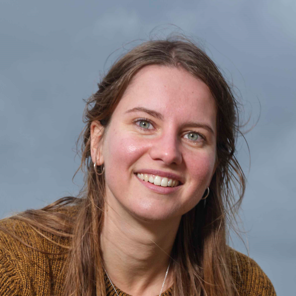Could oysters hold the pearl of wisdom for reef restoration?
A TU Delft Master’s project tries to make large-scale reef restoration possible with a pilot project to re-establish oysters in the North Sea.
TU Delft design alumna, Anne Raspoort, grew up in Aruba in the Caribbean. Thinking back to her formative years on the island, she recalls: “I spent a lot of time at the beach, swimming and snorkelling amongst the coral. Looking back, I took the coral reefs for granted. These underwater landscapes – beautiful as they were - seemed like a given. It was only as I grew older that I came to understand just how fragile reefs are. How susceptible they are to damage or even extinction”.
When the 25-year-old was looking for a graduation project for her Integrated Product Design Masters degree at TU Delft, she thought back to her childhood, and found a desire to preserve reefs for future generations.
Looking at the local situation in the Netherlands, with advice from Wageningen University, her focus changed from coral reefs to the flat oyster reefs that used to cover the bottom of the North Sea but have been victims to bottom trawling, pollution and over-fishing.
“In the Netherlands, the oyster reefs have largely disappeared due to overfishing, disease and destruction of the ocean floor,” she says. “The oysters don’t have a place to start. Larvae float around in the sea and lack a hard surface to settle on and grow. That’s how a reef starts. If the hard substrate is not available, as is the case in our North Sea, they will die off.”
Building blocks
Just like coral, oysters offer the potential to form the building blocks for a reef, around which a marine ecosystem can grow. When Raspoort met marine biologist and managing director of BlueLinked, Michaël Laterveer, he already had a plan – which he had originally envisaged for coral reefs. “The main idea is that if you want to get a reef to recover, you need to start with the foundation – reef builders, organisms that live on the floor that provide the hard substrate that other fish and organisms like,” explains Raspoort. “It brings protection and provides food. In a coral reef, it’s the coral that does this job, but oysters also provide this function.
“His idea was to let the larvae establish themselves on a hard surface in an aquarium or hatchery and grow them until they are healthy and large enough to survive. You would place them in the ocean and let them get used to the conditions. They would start to grow a shell in response to the strength of the current and the hard surface would gradually decompose in the water. You would be left with the beginnings of a reef - initiated in a minimally invasive manner. That was Laterveer’s idea. What he didn’t know though was what the hard surface might look like or how to produce it.”
There are already various projects trying to bring oysters back to the North Sea, growing the molluscs to full size and then releasing them, seeding larvae and trying to encourage colonies at the base of wind farms – but the challenges are in acclimatising the oysters, giving larvae somewhere to settle and introducing them successfully and at scale.
Research
Raspoort began to research marine ecosystems. She looked into the kind of conditions which allow oyster larvae to thrive. She explored the types of materials that might offer sufficient stability but that would also biodegrade. Materials that would be easy to work with in a lab and then take out to the ocean.
“We needed a product that could be transported from the aquarium to the ocean, thrown in the water and would land in a certain way that would not crush the larvae,” she says. “It needed to be stable on the ocean floor and it needed to break down within two to five years.”
Another prerequisite was that the structure needed to protect the oyster larvae from being buried by sand, so they still had access to the current to feed and breathe. People needed to be able to touch the structure without damaging the larvae, and it needed to sink effectively.
Drawing inspiration from structures used in offshore engineering (albeit at a much smaller scale), Anne developed and went on to test two prototype shapes under a current in TU Delft’s Civil Engineering WaterLab. The final result of this design process is The Reef Tile.
The tile is made from calcium-based materials, which oysters like, but which will also biodegrade and benefit the environment. The shape, meanwhile, is “a sort of triangular pyramid shape. You can stack the tiles efficiently and only the surface you want the larvae to settle on is exposed,” she says. “It creates small micro-habitats where the larvae feel more protected. It’s designed so the surface where the larvae settle will never touch the ground, so they will never get crushed and they always have access to flowing water. It can land in several directions. Most things in marine conservation are bulky - but this product fits in your hand. That means all communities are able to do reef restoration as there’s no need for large vessels or specific equipment, it’s easy to transport over the world and therefore it’s scalable.”
Pilot
BlueLinked is currently organising a pilot study together with marine company Boskalis and foundation De Rijke Noordzee at a location in the North Sea near the wind farm area and the site where the oyster beds originally thrived. It is also applying for patent protection, including for a ‘circular’ process it has developed to seed and nurture the larvae.
“The pilot project will start in the summer of 2023”, explains Anne Raspoort. “We will test 1000 pieces with three different surfaces to see how well the oyster larvae attach. The tiles will be dropped in the harbour of Rotterdam. Additionally we will drop 5000 tiles to assess how well they preserve and if other organisms also want to attach. So the goal is to also test ecological aspects in near shore surroundings and to exam different ways of monitoring, with underwater drones for example.”
Raspoort design skillset including her ability to look at the bigger picture and zoom into the detail, has been fundamental to her successful collaboration with a marine biologist.
She traces back her thought process: “Why do you want this tile to be small? Because we want to scale the result. What would the material look like? It’s a product after all, and looking at the big picture is helpful.
“In design, we usually take the human as a starting point, or make the life of humans better. But this project had the ecosystem as a starting point.”
Design solves problems
In her view, the best design is not just about aesthetics but about solving critical problems for humanity. “I really enjoy creating things, and also creating things with a meaning,” she says. “Coming up with ways to solve problems, including problems that people never knew they had. I think design can really improve people’s lives.
“One other project I worked on during my Master’s involved water filter you could attach to a jerry can that could be used by people in rural, sub-Saharan Africa, giving them access to clean drinking water. It’s good that there’s more emphasis on design for solving large world problems right now.”
Raspoort has now completed her Master’s and handed over the project to BlueLinked to test and refine. “I really hope this product can be an effective tool for reef restoration,” she says. “The pilot will be an educational experience. If it turns out that it doesn’t work, we will also gain insights. We need all the information we can get.”
For her, commercialisation is less important than being part of a team addressing global ecological challenges. And what if - a decade down the line - Dutch diners can enjoy the fruits of her labours? “Actually,” she adds, “I’m vegetarian. But I do like the ocean, and reefs, and watching the animals. That’s super nice.”
Michaël Laterveer, managing director of BlueLinked marine environment consultancy, is pleased with the ongoing work with Raspoort and TU Delft.
“The collaboration was initiated by Anne who found our company because she had her own ideas about reef restoration,” he explains. “She was surprised about the fact that her initial idea of creating seedable substrates had already been developed for coral reef restoration at BlueLinked. The big question remained whether these tiles for reef restoration were suitable for a North Sea environment and for the restoration of flat oyster reefs. This led to her project to investigate the correct form, size and material of the reef tiles for a broader spectrum of reef restoration projects.” He said that she and TU Delft had been helpful in applying for a patent – which is unavoidable in the competitive offshore industry, although the company has a broader spirit of openness and cooperation. The next steps are to create master moulds for production, created by 3D printing, and then restoring one hectare of flat oyster reef as a pilot study.

![[Translate to English:] Anne Raspoort with reef tiles for North Sea (Photography by Frank Auperle)](https://filelist.tudelft.nl/IO/Onderzoek/Discover_Design/Anne%20Raspoort/ARaspoort_FAU25414sadpc.jpg)


